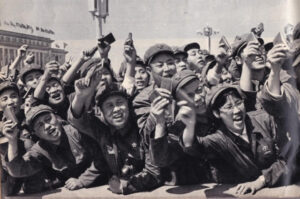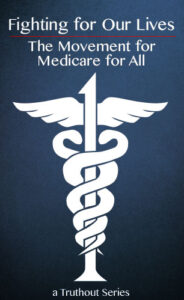De rode loper naar Peking
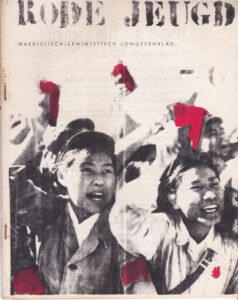 ‘Harde acties, die kunnen verschillen van het opsluiten van een directeur van een bedrijf, het bezetten van een fabriek, om het kapitalistische systeem in desorganisatie te brengen. Dat zou ook kunnen door sabotage bij belangrijke bedrijfsafdelingen, denk aan Philips.’ – Willem Oskam, televisie-interview
‘Harde acties, die kunnen verschillen van het opsluiten van een directeur van een bedrijf, het bezetten van een fabriek, om het kapitalistische systeem in desorganisatie te brengen. Dat zou ook kunnen door sabotage bij belangrijke bedrijfsafdelingen, denk aan Philips.’ – Willem Oskam, televisie-interview
Nieuwezijds Voorburgwal, jaren negentig
De Nieuwezijds Voorburgwal in Amsterdam, begin jaren negentig. Achter de kassa van Modern Antikwariaat Van Gennep staat een norse man met het postuur van de Dokwerker.
Zijn enige politieke activiteit is nog het afrekenen van verramsjte boektitels over China, de Sovjet-Unie en van marxistische denkers als Antonio Gramsci en Alexandra Kollontai. Ooit was hij letterlijk en figuurlijk als voorzitter het boegbeeld van de Rode Jeugd, de revolutionaire jongerenorganisatie die in de tweede helft van de jaren zestig en begin jaren zeventig aan de stoelpoten van de gevestigde orde in Nederland knaagde. Willem Oskam heet hij, bijgenaamd Rooie Willem, of Dikke Willem. Zijn politieke activiteiten heeft hij achter zich gelaten en ingeruild voor een fervent supporterschap voor Ajax.
Nieuwezijds Voorburgwal, 14 juni 1966
Amsterdam, de Nieuwezijds Voorburgwal, 14 juni 1966. Een dag eerder is in Amsterdam het Bouwvakkersoproer uitgebroken. Bouwvakker Weggelaar sterft tijdens een demonstratie.
Getroffen door een steen, gegooid uit eigen gelederen, zo meldt De Telegraaf. Vanwege deze – onjuiste – berichtgeving proberen woedende bouwvakkers de volgende dag met emmers zand het gebouw van de krant binnen te dringen. Het zand moet in de persen, het drukken van de krant moet gestopt worden. Een vrachtauto en rollen krantenpapier worden in brand gestoken. Op dat moment rijdt Willem Oskam in het busje van zijn baas over de Nieuwezijds.
Hij parkeert het busje langs de kant en dringt te midden van bouwvakkers het gebouw binnen. Telegraafmedewerkers proberen de bouwvakkers tegen te houden. Ver komen de mannen niet, de persen zijn onbereikbaar. Wanneer Oskam later die dag het busje aflevert bij zijn baas, krijgt hij te horen dat hij de volgende dag niet meer terug hoeft te komen.
Havenarbeider
Willem Oskam (1943-2000) was de zoon van een havenarbeider uit een communistisch nest. Zijn vader was lid van de communistisch georiënteerde Eenheids Vakcentrale. Thuis werd trouw De Waarheid gelezen. Zijn jeugd offerde hij naar eigen zeggen op aan zijn ideaal: het communisme.
Oskam vertelde later dat hij tijdens zijn fanatieke, revolutionaire jaren iets weg had van een Jehova’s Getuige. Ook tijdens zijn meest fanatieke jaren woonde hij bij zijn ouders op zolder en voor ‘lonende relaties met het andere geslacht’ had hij simpelweg geen tijd. Hij werkte in Amsterdam als havenarbeider, als chauffeur en later op het Internationaal Instituut voor Sociale Geschiedenis (IISG). Hij was actief in de CPN en maakte propaganda voor het communisme. Hij zorgde dat hij politiek geschoold werd door de werken van Lenin, Stalin en Mao Zedong te lezen en bouwde zo een indrukwekkende kennis over het marxistisch- leninistisch gedachtegoed op.
Spruitjeslucht
Tot diep in de jaren vijftig was Nederland een betrekkelijk ouderwets land. Men bleef over het algemeen trouw aan de tradities en gewoonten die al voor de Tweede Wereldoorlog hadden gegolden. Hoge geboortecijfers en frequent kerkbezoek werden in stand gehouden door de gevestigde katholieke en protestantse zuilen. De lonen waren relatief laag, arbeidsonrust was er nauwelijks en van emancipatie hadden nog weinigen gehoord. Weinig vrouwen werkten buitenshuis. De vaderlandse politiek leek zich tijdens de wederopbouw grotendeels volgens het vooroorlogse stramien te herstellen. In de jaren zestig echter ontstonden maatschappelijke en politieke bewegingen die zich wilden ontdoen van de benauwende spruitjeslucht en het maatschappelijke patroon van de jaren vijftig. Hoewel betere onderwijskansen, zorg en ouderdomsvoorzieningen voor iedereen een zorgeloze toekomst beloofden, bleken vooral jongeren zich niet altijd meer te kunnen vinden in de voorgespiegelde toekomst met een huis, gezin, werk, auto en televisie. Het vooruitzicht een leven te leven net als je ouders, met ingebakken omgangsvormen – een eentonig en gezapig bestaan – leek velen toch niet zo aanlokkelijk.
Verzet
Halverwege de jaren vijftig bood de rock-‘n-roll zulke jongeren een uitlaatklep. Door te genieten van andere muziek dan waar je ouders naar luisterden, ontstond de mogelijkheid je af te zetten tegen de leefwijze en opvattingen van ouders en andere opvoeders. Een andere haardracht en andere kleren onderstreepten dat gevoel. In de jaren zestig werkte de popmuziek als een soort slinger om het aanwakkerende verzet tegen de opvattingen van ouders, leraren, gezagsdragers, dominees en priesters, te verwoorden.
Mede onder invloed van de Koude Oorlogsdreiging en de oorlog in Vietnam ontstond in de jaren zestig onder jongeren het streven naar een andere inrichting van de samenleving. Het was vooral de beweging Provo die uiting wist te geven aan het groeiende besef dat de samenleving fundamenteel anders ingericht moest worden.
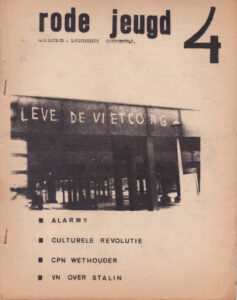 Maoïsten
Maoïsten
Maar ook in de traditionele linkse politieke partijen in Nederland rommelde het. Binnen de Communistische Partij Nederland (CPN), die altijd klakkeloos de lijn van Moskou had gevolgd, ontstonden zelfs dissidente stromingen.
Willem Oskam, lid van de CPN, was in 1966 betrokken bij De Rode Vlag, een kritisch communistisch tijdschrift, wat de vreedzame overgang naar het socialisme zoals Moskou die voorstond, afwees. Men zag het Chinese communisme als het enige zuivere richtsnoer van het communisme. Volgens Moskou volgde Peking te dogmatisch de marxistisch-leninistische leer. Terwijl Peking vasthield aan de stalinistische lijn, had Moskou deze juist opgegeven.
Naar aanleiding van de ideologische breuk tussen China en de Sovjet-Unie voerde Paul de Groot, partijleider van de CPN, in 1964 de ‘neutraliteitspolitiek’ in. Door de CPN werd voortaan Moskou noch Peking gevolgd, ‘maoïstische elementen’ werden geroyeerd en aan de leden rond De Rode Vlag werd gevraagd te kiezen voor een publieke schuldbekentenis en braaf partijlid te blijven of op te stappen. China-gezinde partijleden kozen voor het laatste of werden geroyeerd.
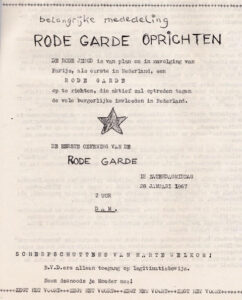 Rode Garde
Rode Garde
In de zomer van 1966 werd uiteindelijk na meerdere pogingen de Chinees-gezinde communisten te herenigen, in het gebouw De Valk aan de Valkenburgerstraat in Amsterdam de Rode Jeugd opgericht. Al gauw volgde ook een tijdschrift met dezelfde naam. Willem Oskam was een van de initiatiefnemers en werd voorzitter van de Rode Jeugd. Anders dan De Rode Vlag, richtte de Rode Jeugd zich nadrukkelijk op werkende jongeren. Want werd in het maoïstisch gedachtegoed tijdens de Culturele Revolutie, niet actief de verbinding met de jeugd gezocht? Jongeren, met name studenten en scholieren, zouden de motor achter de revolutie kunnen vormen, net zoals de Rode Garde in de Volksrepubliek ten tijde van de Culturele Revolutie. De Rode Jeugd omschreef zichzelf als een ‘offensieve verzetsorganisatie’ uitgaand van marxistisch-leninistische gedachtegoed. Het uiteindelijke doel: de vernietiging van het kapitalisme. De aanhang van de Rode Jeugd bestond uit scholieren, werkende jongeren en studenten. Op haar hoogtepunt had de beweging tussen de twee- en driehonderd leden in verschillende afdelingen in het land. Met de leuze ‘Jeugdloon is diefstal’ werd actie gevoerd voor een betere rechtspositie en een betere betaling van werkende jongeren.
Politiek toerisme
De Rode Vlag werd in het geheim politiek en financieel gesteund door de Chinese Communistische Partij, de Albanese Communistische Partij en de maoïstische Kommunistische Partij van België onder leiding van Jacques Grippa. Al voor de oprichting van de Rode Jeugd was Oskam een regelmatig bezoeker van de Chinese ambassade in Den Haag. De oprichting van de Rode Jeugd is in wezen het startsein van Oskams’ politieke toerisme. Voor de voorzitter van de Rode Jeugd werd door Peking de rode loper uitgerold. Oskam bezocht de Volksrepubliek een aantal malen, maar een kritiekloze volgeling van Mao Zedong was hij niet. In literatuur over de Rode jeugd wordt hij wel getypeerd als maoïst, maar correct is dat niet. Ideologisch volgde hij de lijn van Lin Biao, tweede man van China, defensieminister en de man achter de Mao-cultus in de jaren zestig. Bovendien de bedenker van het Rode Boekje van Mao. Lin Biao stond een andere communistische koers voor dan Mao.
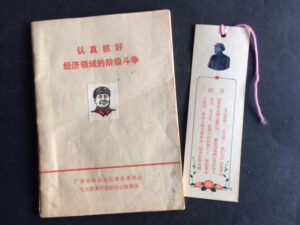 Voorhoede
Voorhoede
Mao streefde naar een communisme binnen één staat, tot stand te brengen met een gewapende strijd, in combinatie met een massale mobilisatie van boeren. De Sovjet-Unie stelde juist het industrieproletariaat centraal in haar strijd.
Lin Biao ging uit van de ‘omsingelingstheorie’. Het kapitalisme en imperialisme van de industrielanden moest op een offensieve manier vanuit de derde wereldlanden bestreden worden. Elk land zou een eigen communistische theoretische leider moeten hebben.
Essentieel is vervolgens de oprichting van een Rode Garde, evenals bijscholing van de jeugd. De zo gecreëerde voorhoede van westerse revolutionairen moet dan onrust en chaos creëren, iets waar de machthebbers de handen vol aan hebben. Juist op dat moment beroven revolutionaire strijders in de derdewereldlanden de westerse mogendheden van de pijlers van het wereldimperialisme, namelijk goedkope grondstoffen en arbeidskrachten. Door het wegvallen van deze twee belangrijke steunpilaren zou het imperialisme wereldwijd ineenstorten.
Vernieling
De Rode Jeugd richtte zich echter niet alleen op de jongeren. In het zesde nummer van de eerste jaargang richtte Oskam zich tot de arbeiders: ‘We kunnen wel door blijven gaan met het opsommen van verdovende middelen, waardoor de arbeider in een comatoestand komt te verkeren […] De bourgeoisie heeft het rotte systeem zo gekamoufleerd, dat vele arbeiders het idee krijgen, dat het allemaal nog niet zo slecht is.’
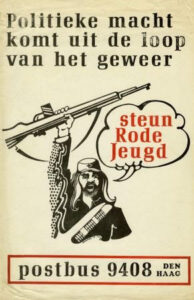 Het werd volgens Oskam tijd dat ook de ‘oudere arbeiders hun TV verlieten en zich bij de reeds demonstrerende, actieve, Rode Jeugd voegden’. Maar het waren met name het Amerikaanse imperialisme, de oorlog in Vietnam en het kapitalisme die het in de opruiende artikelen in De Rode Jeugd moesten ontgelden. De eerste pamfletten van de beweging riepen op tot vernieling van vestigingen van Amerikaanse bedrijven en het Amerikaanse consulaat.
Het werd volgens Oskam tijd dat ook de ‘oudere arbeiders hun TV verlieten en zich bij de reeds demonstrerende, actieve, Rode Jeugd voegden’. Maar het waren met name het Amerikaanse imperialisme, de oorlog in Vietnam en het kapitalisme die het in de opruiende artikelen in De Rode Jeugd moesten ontgelden. De eerste pamfletten van de beweging riepen op tot vernieling van vestigingen van Amerikaanse bedrijven en het Amerikaanse consulaat.
Niet verwonderlijk dat door deze felle agitatie de groepering al gauw de aandacht trok van de politieke inlichtingendienst PID, de binnenlandse veiligheidsdienst BVD en de militaire inlichtingendienst. Na een demonstratie waarbij de politie nadrukkelijk aanwezig was, schreef Oskam in een artikel: ‘Verschillende opvallend onopvallende figuren, aan wier intelligent snuitwerk het duidelijk te zien was, dat zij ‘stillen’ waren, hielden zich druk bezig met foto’s maken vanaf het trottoir of vanuit wagens die niet direct als politiewagens te herkennen waren.’
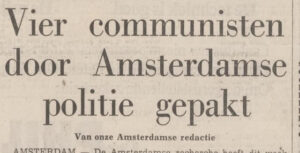 Opruiing
Opruiing
De aandacht in de media voor de Rode Jeugd was vooral terug te voeren op de arrestatie van enkele redacteuren. Dit naar aanleiding van een als ‘opruiend’ gekwalificeerd pamflet.
Waarschijnlijk was een column van Volkskrant-columnist Godfried Bomans de oorzaak. Bomans had op 10 juni 1966, vermoedelijk hoogstpersoonlijk door Willem Oskam, een ‘slordig gedrukt en slecht geschreven’ pamflet in handen gedrukt gekregen. Op de zaterdagse voorpagina van 18 juni 1966 sloeg hij alarm en opende hij de aanval op de ‘raddraaiers’.
Aangezien in het pamflet het redactieadres Kloveniersburgwal 18 was vermeld, kostte het de politie geen moeite de schrijvers van het pamflet te achterhalen en te arresteren wegens opruiing. Willem Oskam kreeg tien dagen cel, evenals redactielid Joost van Steenis en een fikse boete van enkele duizenden guldens. Bekende linkse intellectuelen als Renate Rubinstein, Han Lammers en Harry Mulisch betuigden hun steun aan de Rode Jeugd.
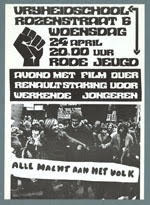 Scholingsavonden
Scholingsavonden
Eind 1967 verbrak de Rode Jeugd definitief haar banden met de Rode Vlag. De connecties die Oskam al had met de Chinese ambassade werden aangehouden. De ambassade zag de Rode Jeugd als een maoïstische voorhoede en schroomde niet de beweging financieel te ondersteunen en de leiding te fêteren op reizen naar de Volksrepubliek.
Naast de talloze acties waaraan hij deelnam – soms ook voor Provo – gaf Oskam scholing over China, het marxisme-leninisme en Lin Biao, op scholingsavonden in Ons Huis in de Amsterdamse Rozenstraat.
Drie keer bezocht Willem Oskam de Volksrepubliek China. Hij behoort tot een van de weinige Nederlanders die eerste minister Zhou Enlai nog de hand hebben geschud. In 1965, nog voor de Culturele Revolutie, ging hij voor de eerste maal met een delegatie naar China.
Ze bleven er zes weken. ‘Daar werd je, bekaf van de reis, door mannen met walkie-talkies op het vliegveld naar zo’n Oostenwindlimousine geloodst en linea recta naar de voetbalwedstrijd Volksrepubliek-Albanië gereden. Enfin, dat was uiteraard alleen maar goed bedoeld,’ schreef Oskam later.
 Kommunistische filosofie
Kommunistische filosofie
Tegen het einde van de zomer van 1966 bereikte de Culturele Revolutie in China het hoogtepunt. Ambtenaren en intellectuelen werden massaal naar werkkampen op het platteland gestuurd om daar ‘de oorspronkelijke communistische mentaliteit op te doen’, miljoenen werden geëxecuteerd en de jeugd werd door Mao gemobiliseerd in de Rode Garde. In de Rode Jeugd (1966, no. 4), juicht Oskam Mao’s initiatieven toe: ‘Deze partij onder leiding van Mao heeft er dan ook voor gezorgd, dat de hongersnood een onbekend verschijnsel is geworden in China en dat er een betere en gelukkigere samenleving aan het ontstaan is. In de werken van Mao Tse-tung vindt men de grondslagen van de kommunistische filosofie en zonder deze is er geen ideale kommunistische samenleving mogelijk.’ En hij vervolgt: ‘De westerse machthebbers zijn bang voor deze filosofie en daardoor gebruiken ze allerlei methoden om deze te belabberen, zodat de westerse mens zich deze ideeën niet eigen zal gaan maken. De berichten over de Rode Garde in de Westerse pers zijn voor een groot deel van twijfelachtige waarde.’
Stalinisme
In de maatregel van Mao een Rode Garde op te richten en de jeugd te mobiliseren zag Oskam veel hoop. In het vierde nummer van de Rode Jeugd kondigde de redactie, in navolging van een groepering in Parijs, als eerste in Nederland, de oprichting van een Rode Garde aan. Doel: optreden tegen de burgerlijke invloeden in Nederland. De eerste oefening stond gepland voor zaterdagmiddag 28 januari 1966, 14.00 uur op de Dam. Zelfs scherpschutters en BVD-ers waren welkom. Wel op vertoon van een legitimatie, zo meldde een pamflet.
De schattingen van het aantal slachtoffers van de Culturele Revolutie loopt uiteen van achthonderdduizend tot vijf miljoen. Vermoedelijk was de Rode Jeugd zich bewust van het grote aantal slachtoffers en vervolgden van de communistische regiems. Maar Oskam schrijft over ‘de verbazing der gehele wereld die het Stalinisme heeft doen oproepen’ en noemt Stalin vooral ‘een realist’. Dit realisme van Stalin heeft weliswaar noodzakelijkerwijs soms een afstotende hardheid, schrijft hij. Zijn conclusie is dat het belangrijker is dat dit realisme een element van stabiliteit in de Russische boerenmassa’s heeft gebracht en bovenal de felbegeerde bolsjewistische revolutie heeft gerealiseerd.
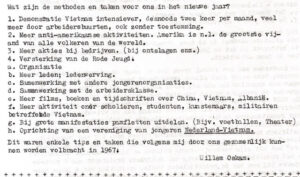 Machtsstrijd
Machtsstrijd
In de hete zomer van 1971 vertrok Oskam opnieuw voor drie maanden naar China, het zeskoppige landelijk bestuur van de Rode Jeugd reisde mee. Het zou zijn derde bezoek aan China worden. Twaalfduizend gulden reisgeld kreeg het bestuur mee, een gift van de Chinese ambassade. Dankzij zijn hechte band met de ambassade werd de delegatie ondergebracht in het luxueuze Peking Hotel. Andere concurrerende delegaties moesten het doen met het Vriendschapshotel. Opnieuw stonden bezoeken aan sportwedstrijden op het programma, maar ook aan katoenfabrieken en scheepswerven.
Willem Oskam is altijd achter de Culturele Revolutie, China en ook Mao blijven staan.
Hoewel zijn denkbeelden naar eigen zeggen in de loop der jaren aan verandering onderhevig waren, sprak hij met afschuw over de revisionistische verkwanseling die Deng Xiaoping met de denkbeelden van Mao had doorgevoerd. Zelfs de machtstrijd die zich tussen Lin Biao en Mao had afgespeeld bracht geen verandering in zijn visie. Het neerstorten van het vliegtuig met Lin Biao onder verdachte omstandigheden wat daarop volgde, evenmin. Ook de ‘vriendschapsband’ tussen de Amerikaanse president Richard Nixon – ‘die het heldhaftige Vietnamese volk belaagde’- en Mao Zedong niet.
Maar na 1971 bezocht Oskam China nooit weer. Hij had geen enkele behoefte ‘een nering van Kentucky Fried Chicken het Plein van de Hemelse Vrede te zien ontsieren,’ zo vertelde hij later.
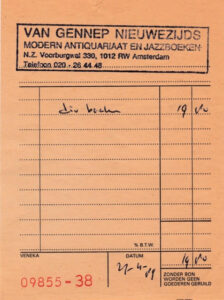 Stamkroeg
Stamkroeg
In 1971 splitste de Rode Jeugd zich op in een legale en een illegale tak. Er volgden geruchtmakende bomaanslagen op Amerikaanse en Turkse instanties, een Philips vestiging en andere imperialistische doelwitten. Eind 1973 hief de Rode jeugd zich op. Met de Rode Hulp, de organisatie die voortvloeide uit de ‘geweldstak’ van de Rode Jeugd, en die zich tot een heuse polder-stadsguerrilla ontwikkelde, had Willem Oskam geen bemoeienis meer.
Zijn laatste jaren sleet hij achter de kassa van Van Genneps Modern Antikwariaat, waar hij menige boekenkoper met zijn barse woorden ‘papiertje of tasje?’ schrik aanjoeg. Vaak was hij te vinden in zijn stamkroeg De Engelse Reet, waar hij met gemak vijftien pils en tien jenever achterover sloeg en geregeld rondjes gaf aan de hele zaak. Iets wat niet te rijmen viel met het bescheiden salaris van een boekverkoper. Na een aantal incidenten in de winkel werd hij ontslagen. Van Rob van Gennep kreeg hij een fikse ontslagvergoeding mee.
In 2000 werd hij op 57-jarige leeftijd op de vervuilde zolder van zijn ouderlijk huis, omringd door boeken, ordners, pamfletten en brochures, dood aangetroffen.
Literatuur en bronnen
– Frans Dekkers, Daan Dijksman, ’n Hollandse stadsguerrilla. Terugblik op de Rode Jeugd, Amsterdam 1988
– Guus Meershoek, De Groep IJzerman, Amsterdam 2011
– Maarten van Riel, Zaterdagmiddagrevolutie. Portret van de Rode Jeugd, Amsterdam 2010
– Antoine Verbij, Tien rode jaren. Links radicalisme in Nederland 1970-1980, Amsterdam 2005
– Geke van der Wal, Rob van Gennep, uitgever van links Nederland, Amsterdam 2016
– De rode jaren, documentairefilm van Leo de Boer, 2005
– Nummers van het tijdschrift De Rode Jeugd

